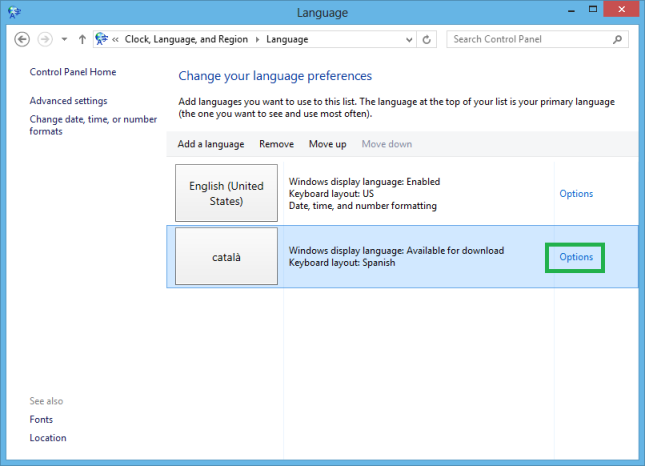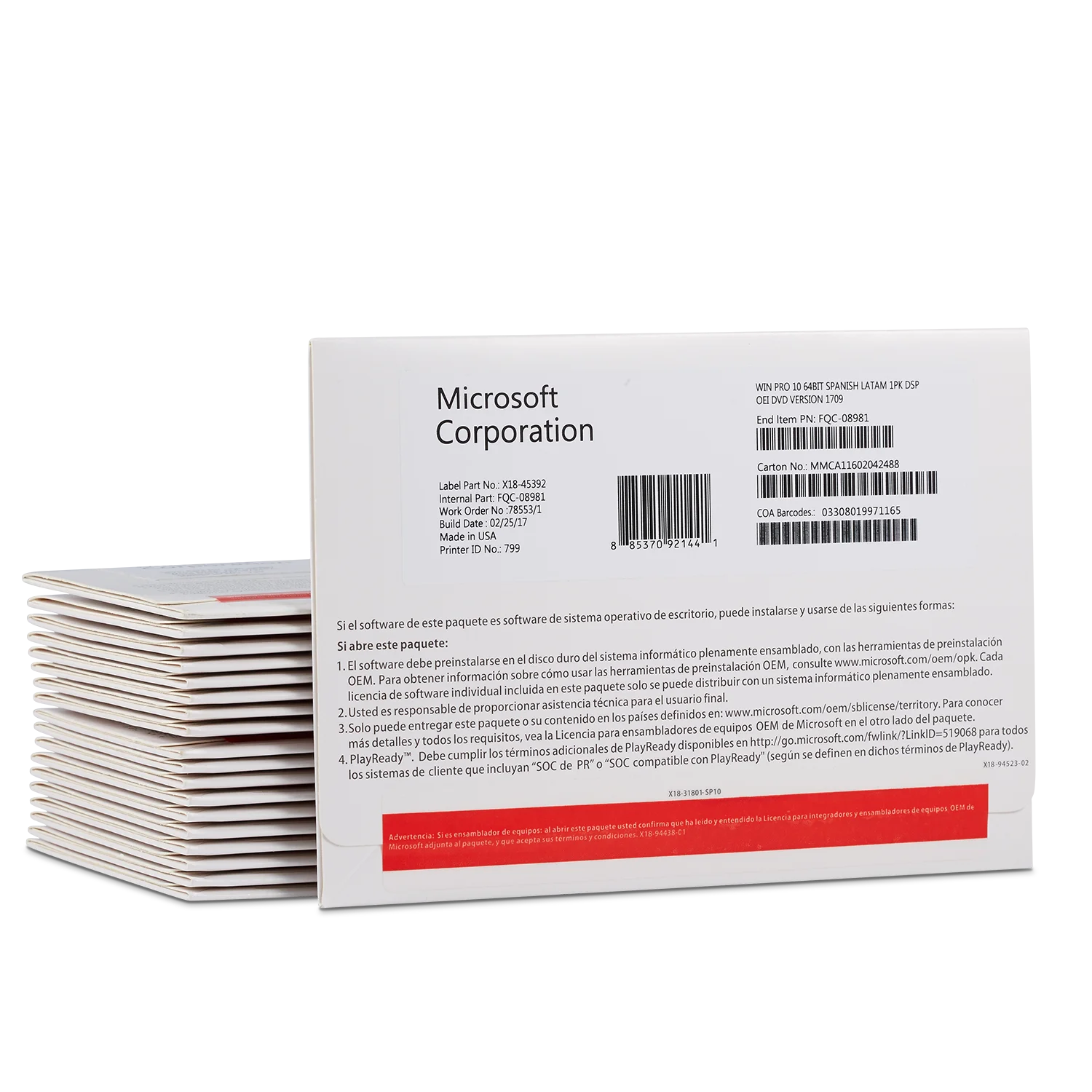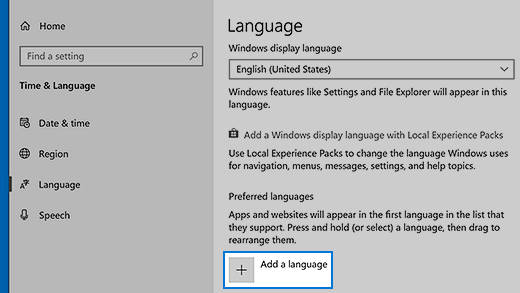-->
MUI stands for Multilingual User Interface. There are full (100%) and partial (80% according to Microsoft) MUI language packs. Full languages change entire Windows 7 environment, partial languages lack some localization and the untranslated user interface is always in English, regardless of the original Windows 7 display language. Nov 28, 2018 For more information, see Language packs. The version of the language, LIP, or Feature on Demand must match the version number. For example, you can neither add a Windows 10 version 1809 LIP to Windows 10 version 1803 image, nor add a Windows Server 2019 language pack to Windows Server 2016.
Summary: Learn about the language packs and language interface packs that are available for Office.
An installation of Office 2016 can include applications or user interface elements in more than one language because some Office 2016 products are not available in every language.
This article describes the language versions that are available for a subset of Office 2016 applications, the Office 2016 applications that will work with Language Interface Packs, and the recommended base languages to install for Office 2016 Language Interface Packs.
Important
This article describes methods of deploying and managing language packs for versions of Office 2016 that use the Windows Installer (MSI) installation technology, which are available for enterprises through volume licensing. If you have an Office subscription and you're deploying Microsoft 365 Apps, which uses the Click-to-Run installation technology, see Overview of deploying languages for Microsoft 365 Apps.
Applications and language availability
In some non-English language versions of Office 2016, a specific Office 2016 application may not be available. For example, Access 2016 is not available in Hindi. Therefore, the Hindi language version of Office 2016 is installed in English.
Some Office applications are not available in some languages. Project 2016 and Visio 2016 are available in a subset of languages, as shown in the following table.
Language availability for the 2016 versions of Project and Visio
| Language | Project 2016 | Visio 2016 |
|---|---|---|
| Arabic | yes | yes |
| Brazilian | yes | yes |
| Bulgarian | no | no |
| Chinese - Simple | yes | yes |
| Chinese - Traditional | yes | yes |
| Croatian | no | no |
| Czech | yes | yes |
| Danish | yes | yes |
| Dutch | yes | yes |
| English | yes | yes |
| Finnish | yes | yes |
| French | yes | yes |
| German | yes | yes |
| Greek | yes | yes |
| Hebrew | yes | yes |
| Hindi | no | no |
| Hungarian | yes | yes |
| Italian | yes | yes |
| Japanese | yes | yes |
| Korean | yes | yes |
| Norwegian (Bokmål) | yes | yes |
| Polish | yes | yes |
| Portuguese (European) | yes | yes |
| Romanian | no | no |
| Russian | yes | yes |
| Serbian (Latin) | no | no |
| Slovak | yes | yes |
| Slovenian | yes | yes |
| Spanish | yes | yes |
| Swedish | yes | yes |
| Thai | no | no |
| Turkish | yes | yes |
| Ukrainian | yes | yes |
Windows 7 Serbian Language Pack
Language Interface Packs
For some languages, Microsoft localizes only some Office 2016 applications and releases them as Language Interface Packs (LIPs). These LIPs localize the user interface only, and not the Help content. Administrators must first install a fully localized base language version (see the table later in this section) of Office 2016, and then install the LIP. Users can then work in their preferred language in the following applications and features:
Excel 2016
OneNote 2016
Outlook 2016
PowerPoint 2016
Shared Office features
Word 2016
Skype for Business 2016, but only for the following languages:
Albanian: sq-SQ
Azerbaijani (Latin): az-Latn-AZ
Basque: eu-ES
Belarusian: be-BE
Catalan: ca-ES
Farsi (Persian): fa-IR
Filipino: fil-PH
Galician: gl-ES
Macedonian: mk-MK
Serbian (Cyrillic): sr-Cyrl-RS
Uzbek (Latin): uz-Latn-UZ
The remaining Office applications appear in the base Office 2016 installation language. The following table lists the base language for each LIP language.
Base languages available for Language Interface Packs
| LIP language | Base language |
|---|---|
| Afrikaans | English |
| Albanian | English |
| Amharic | English |
| Armenian | English |
| Assamese | English |
| Azerbaijani - Latin script | English |
| Bangla (Bangladesh) | English |
| Basque (Basque) | Spanish |
| Belarusian | Russian |
| Bengali - India | English or Hindi |
| Bosnian - Latin script | English |
| Catalan | Spanish |
| Dari | English |
| Filipino | English |
| Galician | Spanish |
| Georgian | English |
| Gujarati | English |
| Icelandic | English |
| Irish - Gaelic | English |
| Kannada | English |
| Khmer | English |
| Kiswahili | English |
| Konkani | English |
| Krygyz | Russian |
| Luxembourgish | French |
| Macedonian (FYROM) | English |
| Malayalam | English |
| Maltese | English |
| Maori | English |
| Marathi | English |
| Mongolian - Cyrillic script | English |
| Nepali | English |
| Norwegian (Nynorsk) | Norwegian (Bokmål) |
| Odia | English |
| Persian (Farsi) | English |
| Punjabi (India) | English |
| Quechua (Peru) | Spanish |
| Scottish Gaelic | English |
| Serbian - Cyrillic script | Serbian (Latin) |
| Serbian - Cyrillic script (Bosnia and Herzegovina) | English |
| Sindhi (Pakistan) | English |
| Sinhala | English |
| Tamil (India) | English |
| Tatar | Russian |
| Telugu | English |
| Turkmen | Russian |
| Urdu | English |
| Uyghur | Chinese (Simplified) |
| Uzbek - Latin script | English or Russian |
| Valencian | Spanish |
| Welsh | English |
For information about how to obtain the LIP you need for your deployment, see Download language packs, language interface packs, and proofing tools for volume license versions of Office.

Related topics
See Full List On Support.microsoft.com
Microsoft has made available for download the language packs for the gold development milestone of Windows 7. The Redmond-based company is attempting to help end users across the world tailor Windows 7 RTM to their specific language. According to the software giant, the language packs for Windows 7 have been released via Windows Update. In this regard, Windows 7 users will have to turn to WU in order to install extra languages into their copy of Windows 7 in addition to the default language.
By offering the language packs through Windows Update, Microsoft is following the same strategy that it did with Windows Vista. In this context, the company is restricting access to the language packs. And, of course, the limitations also survived from Vista. Microsoft permitted only users of the two high-end editions of Windows Vista to install additional languages, Enterprise and Ultimate. The same is the case for Windows 7.
“These language packs are available to our enterprise customers running Windows 7 Enterprise and Windows 7 Ultimate RTM versions only. Customers on the Windows 7 Release Candidate are not eligible for these language packs,” revealed Microsoft’s Stephen L. Rose.
Essentially, users running the RTM build 7600.16835 of Windows 7 Enterprise and Ultimate can go to Windows Update and identify the language packs offered as updates for the operating system. At the same time, only Windows 7 RTM Enterprise and Ultimate are designed to integrate the language packs. This because the two editions are the only SKUs that come with support for Multilingual User Interface Packs (MUI Packs).
“Traditional Chinese –Taiwan will be released at a later date,” Rose stated. Microsoft did not indicate when exactly the Traditional Chinese –Taiwan language pack would be offered to Windows 7 RTM customers, but there are more than enough language packs to keep users busy.
Serbian Latin Language Pack Windows 7 Microsoft Word
Here are the Windows 7 RTM Enterprise and Ultimate language packs that Microsoft did release:

Windows 7 Language Pack Download
ArabicBrazilianPortugueseBulgarianChinese – SimplifiedChinese – Traditional – Hong KongCroatianCzechDanishDutchEnglishEstonianFinnishFrenchGermanGreekHebrewHindiHungarianItalianJapaneseKoreanLithuanianNorwegianPolishPortugueseRomanianRussianSerbian LatinSlovakSlovenianSpanishSwedishThaiTurkishUkrainian.